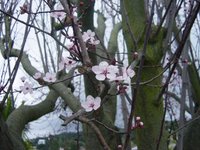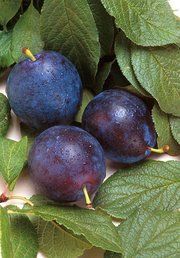Plum
|
|
- "Plum" is also a nickname for British humorist P.G. Wodehouse.
| Plum | ||||||||||||||
|---|---|---|---|---|---|---|---|---|---|---|---|---|---|---|
| Missing image Plums_hanging.jpg Plums | ||||||||||||||
| Scientific classification | ||||||||||||||
| ||||||||||||||
| Genera | ||||||||||||||
|
Several, including: |
A plum is a stone-fruit tree in the genus Prunus. Its fruit is sweet, juicy and edible, and it can be eaten fresh or used in jam-making or other recipes. Plum juice can be fermented into plum wine; when distilled, this produces a brandy known in Eastern Europe as Slivovitz. Dried plums are known as prunes. Prunes are sweet and juicy, and they have a very high dietary fiber content, so prune juice is often used to help regulate the functioning of the digestive system. It also contains several antioxidants that may slow aging. Prune marketers in the United States have, in recent years, begun marketing their product as "dried plums", because "prunes" has negative connotations of being unappetizing, and suitable only for the elderly.
Prune kernel oil is made from the fleshy inner part of the pit of the plum.
Plums come in a wide variety of colours and sizes. Some are much firmer-fleshed than others and some have yellow, white, green or red flesh, with equally varying skin colour.
Plum varieties and species in use today include:
Species
- Prunus domestica (common plum)
- Prunus insititia (damson, damson plum, bullace)
- Prunus maritima (Beach plum)
- Prunus salicina (Japanese plum)
Selected cultivars
- Damson, or Damask Plum
- Greengage, or greengage plum (firm, green flesh and skin even when ripe)
- Mirabelle (a dark yellow plum predominantely grown in France)
- Satsuma plum (firm red flesh with a red skin)
- Golden or yellowgage plum (like the greengage, but yellow)
- Ume a small sour plum used in pickles
When it flowers in the early spring, a plum tree will be covered in blossom, and in a good year approximately 50% of the flowers will be pollinated and become plums. Flowering starts after 80 growing degree days.
If the weather is too dry the plums will not develop past a certain stage, but will fall from the tree while still tiny green buds, and if it is unseasonably wet or if the plums are not harvested as soon as they are ripe, the fruit may develop a fungal condition called brown rot. Brown rot is not toxic, and very small affected areas can be cut out of the fruit, but unless the rot is caught immediately the fruit will no longer be edible. Plum is used as a food plant by the larvae of some Lepidoptera including November Moth, Willow Beauty and Short-cloaked Moth.
Prunusdmoestica01.jpg
The plum blossom, along with the peony, are considered traditional floral emblems of China. In June 21, 1964, the Executive Yuan of the Republic of China officially designated the plum blossom to be its national flower, with the triple grouping of stamens (one long and two short) representing the Three Principles of the People and the five petals symbolizing the five branches of the ROC government. [1] (http://www.mofa.gov.tw/webapp/np.asp?ctNode=446) The designation, repeats a previous statement by the ROC government in 1929. [2] (http://www.china.org.cn/english/environment/64698.htm)
It is native to Taiwan and has been increasingly used as the national emblem of the Republic of China, just as the 12-ray sun originated from the Kuomintang party flag.
Missing image Plum2web.jpg Plum (variety Tucker) - watercolor 1894 | Missing image Plum1web.jpg Plum (variety Pacific Prune) - watercolor 1893 | Missing image Plums.jpg Plums |
Missing image Plum_flowers.jpg Plum Flowers |
Template:Commons
Template:Wiktionary
See also
External Links
- Plum nutrition information (http://www.kallipolis.com/diet/food.php?id=9279&w=2)
- Prune nutrition information (http://www.kallipolis.com/diet/food.php?id=9291&w=2)
de:Pflaume fi:luumu fr:Prune eo:Pruno he:שזיף gl:Ameixeira, froito nl:Pruim pt:Ameixeira sv:plommon


